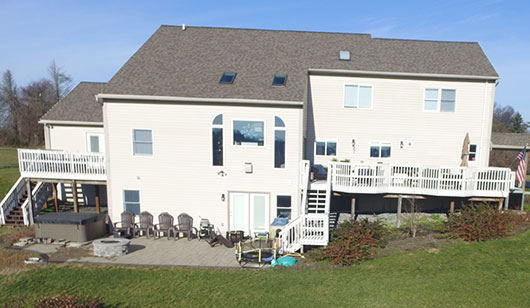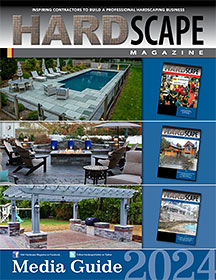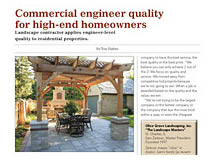Articles written by guest contributors

Our journey to patios – and decks
By Jeremy MartinLike many in the hardscape industry, my roots are in landscaping. I grew up in the horticulture world, as my mom had a small greenhouse and specialized in collector plants. From the time I had my driver’s license at age 16, I was working in landscaping. Even before that, I was helping a family friend maintain landscapes. I spent the next 4+ years working in landscaping before my brother and I launched Willow Gates Landscaping in 2005.
Willow Gates followed a common path of many hardscape contractors. Our first year? Strictly landscaping, other than 2 tiny retaining walls. Second year? My brother thought hardscaping would really be a great way to fill in the summer slump, so we did a few small patios that season. Each successive year, we kept building up the hardscape division.
In hindsight, our marketing spend was much too low; but the money we did invest in marketing was largely targeted at hardscaping. Our typical season began with spring landscape maintenance in March, and we would start hardscaping around late June to early July.
Today, hardscaping represents the majority of our revenue. We’ve pushed to work year round, developing new techniques that allow us to build through cold weather with the same quality control. Willow Gates’ journey from landscaper to hardscaper is probably similar to many of today’s hardscapers.
While I have no research to back this up, I’d venture a guess that 70% of hardscapers started as landscapers, 20% branched out from traditional masonry, and perhaps 10% launched their business as hardcapers from day 1. Again, no research on this so feel free to dispute this!
In 2011, my brother left the partnership to pursue his dream of a family dairy. Since he had headed up the hardscape projects, it was time for me to get much more involved beyond design and sales.
I had a nagging belief that we were quite average hardscapers… and I hated that! So beginning in 2012, I went all in on education. I went to every course or event that I could, and the Mid Atlantic Hardscape Show (MAHTS) was instrumental in our growth as a company.
At one presentation, I listened to the owner of a large, successful company make the most depressing statement. He said to choose whether you wanted to be the subcontractor or the general contractor. Well, I was most definitely not prepared to be a GC! Still, I wanted control of the creative process and I knew that would mostly be lost if I was a subcontractor. Well, that was 13 years ago… and today, Willow Gates is that GC!
In today’s outdoor living market, decks are a hot trend just like hardscaping. The deck market has rapidly advanced. Look at any outdoor living area from 20 years ago and compare it to today. The materials, the designs, the accessories… everything has evolved dramatically! So why should you add decks to your services instead of sticking to hardscapes? After all, isn’t our specialty ripping out old rotting decks and replacing them with patios?
Cost.
Let’s face it, it’s possible to build raised patios. In fact, we’ve built many of them. But once you start raising a patio 3’ to 4’ above grade, other issues present themselves. It takes a lot of time to build a retaining wall, backfill, and compact to raise the grade that much. We also introduce a very significant load to the foundation walls. In many cases, a raised patio can be done… but it’s at a higher cost than a deck.
Feasibility.
Sometimes a homeowner wants an outdoor living space connected to their first floor, but they have a walkout basement. Yes, we could use steel framing, pour a suspended slab, and overlay with concrete pavers or natural stone. There are also methods to install patios on top of deck framing. But let’s face it… a deck simply is much more practical!
Design.
A well designed deck that integrates well with a patio adds another layer of sophistication. A multi-level, multi-use outdoor living area is a significant investment! Decks add something that a patio can’t. Since they are built as frost free structures, it’s easier to add screens and heaters to them than to a patio.
Opportunity.
Many homeowners want both a deck and a patio. They could pursue separate designs from a deck builder and a hardscaper, and in the past I think that was somewhat common. But when 2 separate features are connected, it’s very difficult to avoid conflicts in the design.
For example, let’s consider a project with a patio area connecting a deck and a pool. The hardscaper plans the patio area, carefully considering slopes, step riser heights, and water management. The deck is built first, and the deck builder collects his check and is on his way. Then, the hardscaper shows up and finds the deck builder changed the elevations. Suddenly, all his plans are wrecked and he’s trying to redesign the project. This creates delays, additional costs, and frequently sacrificing elements of the original design.
Today’s homeowners are more savvy than ever. They have endless places to find inspiration for their dream space. AI can serve up a lot of inspiration. Social media. Marketing in every imaginable way. But they’re also more distracted than ever, and they don’t want the frustration of dealing with multiple contractors. They really want to trust the process to one company. And this is how we found ourselves managing hugely complex projects!
We still don’t build decks
So how does my crew build decks or roofs? We don’t! We use subcontractors. While we have many of the tools to build decks, I prefer to keep my crews building patios and landscapes. It doesn’t make sense for us to abandon those profitable projects just to chase a new shiny object like decks or pools. Instead, we design, sell and manage these projects. Our crews will take care of demo and footings; beyond that, it’s mostly managing the build process. While a deck project often includes hardscape, landscape, lighting, or all of the above… we have a few where we only installed footings at the start and lawn restoration at the end. Here are some tips for adding decks to your services.
Genuine interest.
It needs to be more than just chasing more top line revenue. Do you want to learn about typical footings, code requirements, how to build a roof structure, decking options, and more? Do you thrive on challenging projects that others would decline? If you don’t have an interest in this, then you’re probably not ready to add decks.
Communication.
Can you communicate adequately with the client and any subcontractors? Will the client trust the process if it’s not your crew? Will you be involved enough to know when a project is going off the rails?
Equipment.
If you choose to collaborate with a deck builder, you don’t need much! You already have excavation equipment, and you likely already have an auger to drill footings. You can rent a concrete buggy or mixer as needed to pour the footings. If you want to install some or all of the deck project, though, you’ll need tools that a hardscaper might not have in the trailer. Multiple types of saws. Nailers. Air compressors. Ladders. Lifts. Scaffolding.
Time.
It takes time to learn the requirements. Time to design. Time to manage the process. Time to develop relationships with architects, engineers and subcontractors. If you’re already over-stressed managing your hardscape projects, then you need to address that first. Topline revenue doesn’t automatically increase bottom line. Don’t sacrifice a profitable hardscape business just to chase a new dream!
In closing, decks are a huge opportunity but are not a good fit for everyone. It worked well for us… so well, that we outgrew our name and just rebranded the company. But that’s another article!
Jeremy Martin co-founded Willow Gates Home & Landscape in 2005. He became a CMHA instructor in 2016. He also founded Dust Killer Tools to help his company meet 2017 OSHA silica standards. Email Jeremy@DustKiller.tools. Visit WillowGatesHome.com and DustKiller.tools















